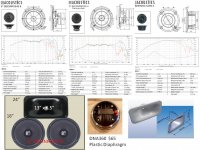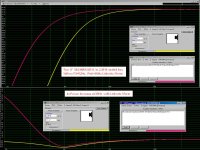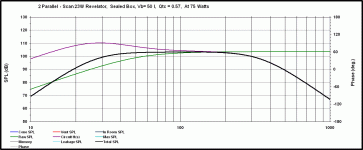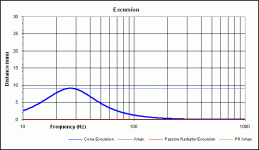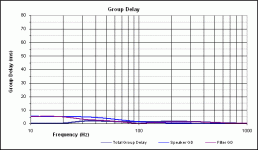Would a large dome mid, such as the ATC, qualify?
It seems like it has the quality and the power handling but it's never going to be within my budget. Let's put it in the "Phase III" camp.
cheers
Doug
If the idea is to recreate the sound of the Gales, some care is needed on finding similar drive units.
It used the Celestion HF2000 mylar plastic dome IIRC. These are rare beasts these days, but here's some similar types:
Vifa D19TD: Vifa D19TD-05 3/4" Poly Dome Tweeter
Visaton DT94: DT 94 - 8 Ohm
Mylar has a smooth inoffensive sound with a characteristic lift in mid treble. It is less harsh than a soft fabric dome, perhaps because damped materials break up more gently. I have some Celestion HF2000 in my old Ditton 44, and I think the Visaton DT94, which I also have, gets close to the original "tone". The Vifa D19TD was fitted in every other seventies speaker too. 🙂
It used the Celestion HF2000 mylar plastic dome IIRC. These are rare beasts these days, but here's some similar types:
Vifa D19TD: Vifa D19TD-05 3/4" Poly Dome Tweeter
Visaton DT94: DT 94 - 8 Ohm
Mylar has a smooth inoffensive sound with a characteristic lift in mid treble. It is less harsh than a soft fabric dome, perhaps because damped materials break up more gently. I have some Celestion HF2000 in my old Ditton 44, and I think the Visaton DT94, which I also have, gets close to the original "tone". The Vifa D19TD was fitted in every other seventies speaker too. 🙂
Because of the high crossover and small size I would not expect the tweeter to have a strong influence on the sound so long as it has a smooth response and wide directivity. The SEAS was selected after a very brief consideration because it is a recognised replacement for the Celestion HF 2000, has good performance and is a modest price.If the idea is to recreate the sound of the Gales, some care is needed on finding similar drive units.
It used the Celestion HF2000 mylar plastic dome IIRC. These are rare beasts these days, but here's some similar types:
Vifa D19TD: Vifa D19TD-05 3/4" Poly Dome Tweeter
Visaton DT94: DT 94 - 8 Ohm
Mylar has a smooth inoffensive sound with a characteristic lift in mid treble. It is less harsh than a soft fabric dome, perhaps because damped materials break up more gently. I have some Celestion HF2000 in my old Ditton 44, and I think the Visaton DT94, which I also have, gets close to the original "tone". The Vifa D19TD was fitted in every other seventies speaker too. 🙂
The Vifa looks to be a similar tweeter though perhaps a bit less smooth but when I looked in the usual place for a Vifa price I could not find it. Nor could I see it listed on the Tymphany website. Has it been discontinued?
The Visaton has a phase shield and looks ugly. The SEAS would seem a safer option unless there is a reason to go for the Visaton?
The midrange will have a larger influence on the sound and I know little about the SB midrange except that it will be well made, is a good price and is the right size. There are not many standard range 4" midranges around.
I don't think the Visaton DT94 is ugly at all!
The phase plate is to make it less bright on axis. A technique that SEAS also use on the 19TAF/G, just you can't see the blob of varnish in the middle of the mesh!
http://www.seas.no/index.php?option=com_content&view=article&id=46:h0532-08-19tafdg&catid=45:seas-prestige-tweeters&Itemid=462
Modern ferrofluid tweeters handle power better than the HF2000, but you will find that mylar has a very different sound from fabric domes like the familiar SEAS 19TFF. Mylar is also much louder for some reason. Perhaps 3dB higher with the Visaton. It has quite a lot of windings on the voicecoil leading to a highish 0.12mH Le.
FWIW, frequency response tells you very little how a speaker sounds. I can make two tweeter filters that measure exactly the same on FR, but sound completely different. That is done by changing the source impedance the tweeter sees with resistors usually, so the impedance curve and electrical damping on the tweeter is different.
An externally hosted image should be here but it was not working when we last tested it.
The phase plate is to make it less bright on axis. A technique that SEAS also use on the 19TAF/G, just you can't see the blob of varnish in the middle of the mesh!
http://www.seas.no/index.php?option=com_content&view=article&id=46:h0532-08-19tafdg&catid=45:seas-prestige-tweeters&Itemid=462
Modern ferrofluid tweeters handle power better than the HF2000, but you will find that mylar has a very different sound from fabric domes like the familiar SEAS 19TFF. Mylar is also much louder for some reason. Perhaps 3dB higher with the Visaton. It has quite a lot of windings on the voicecoil leading to a highish 0.12mH Le.
FWIW, frequency response tells you very little how a speaker sounds. I can make two tweeter filters that measure exactly the same on FR, but sound completely different. That is done by changing the source impedance the tweeter sees with resistors usually, so the impedance curve and electrical damping on the tweeter is different.
Last edited:
Beauty is in the eye of the beholder and particularly if that is one of your speakers!I don't think the Visaton DT94 is ugly at all!
I do not understand. The transfer function is to remain the same (amplifier voltage as input and cone velocity as output) and yet changes to the crossover will change the sound but not the cone velocity? These are not nonlinearities?FWIW, frequency response tells you very little how a speaker sounds. I can make two tweeter filters that measure exactly the same on FR, but sound completely different. That is done by changing the source impedance the tweeter sees with resistors usually, so the impedance curve and electrical damping on the tweeter is different.
Andy, to reject a tweeter because you don't like the look of it is to miss the point here. I know exactly how soft domes sound:
This is the Wilmslow preferred Morel CAT 298 replacement for the old mylar KEF T27. It works on level, but I actually doubt if it sounds like a T27 at all! 😀
If you want to understand how source impedance affects the timbre of a speaker, get any old bass unit and tap the cone with the terminals open circuit or short circuited with something metal. Sounds different, eh? I rest my case. 😎
An externally hosted image should be here but it was not working when we last tested it.
This is the Wilmslow preferred Morel CAT 298 replacement for the old mylar KEF T27. It works on level, but I actually doubt if it sounds like a T27 at all! 😀
If you want to understand how source impedance affects the timbre of a speaker, get any old bass unit and tap the cone with the terminals open circuit or short circuited with something metal. Sounds different, eh? I rest my case. 😎
What compression driver did you have in mind?
cheers
Doug
For a SEOS12 waveguide based design, a plastic diaphragm is considered smoother at high frequencies than an aluminum diaphragm.
For a standard driver design, the SB Acoustics drivers provide good quality at a fair price in the USA. Attached pictures shows how a Linkwitz Transform can provide 30Hz bass with two SB23NRXS45-8 woofers in a 2.8cuft sealed box at a worst case 6x power increase at 30Hz.
8” SB23NRXS45-8
5" SB15NRXC30-4
1" B29RDNC=C000-4
SB drivers are manufactured in India, so the high prices must be from limited local vendor interest. I hope the Linkwitz Xform power data will help your decision options with whatever woofer you select.
Attachments
What happens in a collaborative project to move things on? Is a choice of drivers pencilled in or, at least, driver sizes settled on so that a cabinet design can be sorted? Designing a crossover may push the design towards or away from particular drivers but obviously needs a reasonably settled first guess for drivers and baffle.
We have a proposal in post #60 using standard range drivers that closely follows the Gale design in box size, driver size and crossover points.
We have a proposal in post #67 using standard range drivers but for a cabinet twice the size of the Gales. The midwoofer and the tweeter are larger than the Gales and would normally use significantly lower crossover points. It looks like a good choice and if well executed may have an edge in sound quality (depending on how you judge such things) but it is hard to see it as much of a homage to the Gale GS401.
How are decisions made in a collaborative project?
We have a proposal in post #60 using standard range drivers that closely follows the Gale design in box size, driver size and crossover points.
We have a proposal in post #67 using standard range drivers but for a cabinet twice the size of the Gales. The midwoofer and the tweeter are larger than the Gales and would normally use significantly lower crossover points. It looks like a good choice and if well executed may have an edge in sound quality (depending on how you judge such things) but it is hard to see it as much of a homage to the Gale GS401.
How are decisions made in a collaborative project?
My apologies I have missed a couple of proposed sets of drivers.
The proposed sets of drivers in post #32 consisting or a TB flat 8", a 3" SS midrange and a 1" SS ring radiator. According to the link, a box size of about 19 litres for 2 drivers gives an F3 of 53 Hz but with low sensitivity. Crossover points of 400-600 and 4k.
The proposed set of drivers in post #33 consisting of SS 21W/8558, CSS 125 midrange and a tweeter. I cannot find the named woofer but assuming the SS 21W/8555 which is current it would ideally like about a 50% bigger box but would not suffer much in 40 litres. Crossover points 400 and 3k.
There have also been individual drivers suggested but given the influence of one driver choice on another I have only collected the sets.
The proposed sets of drivers in post #32 consisting or a TB flat 8", a 3" SS midrange and a 1" SS ring radiator. According to the link, a box size of about 19 litres for 2 drivers gives an F3 of 53 Hz but with low sensitivity. Crossover points of 400-600 and 4k.
The proposed set of drivers in post #33 consisting of SS 21W/8558, CSS 125 midrange and a tweeter. I cannot find the named woofer but assuming the SS 21W/8555 which is current it would ideally like about a 50% bigger box but would not suffer much in 40 litres. Crossover points 400 and 3k.
There have also been individual drivers suggested but given the influence of one driver choice on another I have only collected the sets.
http://www.beyma.com/uploads/ftp/Fichas_Tecnicas/000000733.PDF
gives a 50Hz F3 in 19L with a 1.5dB peak at around 80Hz (ie just where the factory figures show a drop).
Crossed at 400-450Hz to
Audax HM100Z0 Aerogel 10cm 4" woofer
Going by published Sd this is effectively a 8cm mid meaning that it will beam at 90deg at about 4200Hz. So that is where I would cross to a 104mm faceplate tweeter mounted on this:
Soundlabs Group WG148R Wave Guide
A Vifa D27TG-35-06 should bolt straight on (4 bolts on a 94mm circle) but a Seas 27TFF H0831 or any other tweeter using 4 bolts on a 92mm circle should be easy to modify by just opening out the mounting holes to 5 or 6 mm.
Make sure that there is no gap, step or sharp corner between waveguide and faceplate to avoid reflections and resonances. Hence only use tweeters with flat faceplates and 4 hole mounting.
A waveguide increases sensitivity at the lower end of a tweeters response but above 4.2k it should be reasonably flat again. Otherwise a single well-chosen capacitor should linearize things.
The Beymas cost £30 each without VAT, the Audax £48 and the tweeters £24 and £20 respectively, making a total cost of drivers of about £148 per speaker plus Aus$19.00 for the WG.
Should hopefully result in speakers in the spirit of the Gales which are fairly efficient and capable of 110dBspl at 1m before running out of puff and linear travel.
gives a 50Hz F3 in 19L with a 1.5dB peak at around 80Hz (ie just where the factory figures show a drop).
Crossed at 400-450Hz to
Audax HM100Z0 Aerogel 10cm 4" woofer
Going by published Sd this is effectively a 8cm mid meaning that it will beam at 90deg at about 4200Hz. So that is where I would cross to a 104mm faceplate tweeter mounted on this:
Soundlabs Group WG148R Wave Guide
A Vifa D27TG-35-06 should bolt straight on (4 bolts on a 94mm circle) but a Seas 27TFF H0831 or any other tweeter using 4 bolts on a 92mm circle should be easy to modify by just opening out the mounting holes to 5 or 6 mm.
Make sure that there is no gap, step or sharp corner between waveguide and faceplate to avoid reflections and resonances. Hence only use tweeters with flat faceplates and 4 hole mounting.
A waveguide increases sensitivity at the lower end of a tweeters response but above 4.2k it should be reasonably flat again. Otherwise a single well-chosen capacitor should linearize things.
The Beymas cost £30 each without VAT, the Audax £48 and the tweeters £24 and £20 respectively, making a total cost of drivers of about £148 per speaker plus Aus$19.00 for the WG.
Should hopefully result in speakers in the spirit of the Gales which are fairly efficient and capable of 110dBspl at 1m before running out of puff and linear travel.
This trick might be the way to use a lower Q driver sealed:
http://www.humblehomemadehifi.com/download/Humble Homemade Hifi_Black Box_copy.pdf
I'd rather break rule 3 though...
http://www.humblehomemadehifi.com/download/Humble Homemade Hifi_Black Box_copy.pdf
I'd rather break rule 3 though...
dual Scan Revelators in 50L box, with your dimensions (adjust depth to 305mm) plus 15% with 12mm Euro Birch Ply, possibly 50-75% fill
this is with LT and LP @350hz
this is with LT and LP @350hz
Attachments
re:"SB drivers are manufactured in India" - ahem... how about Indonesia?
Doh! I must have used Homer Simpson geography where INDIA is in IND_ones_IA
Hi All
I'm on my way home again after a couple of days away. It's encouraging to see the level of interest and discussion. In the next day or so I'll tabulate all of the driver suggestions to date, adding links to their data, so that everyone can have a point for quick reference into the future.
Cheers
Doug
I'm on my way home again after a couple of days away. It's encouraging to see the level of interest and discussion. In the next day or so I'll tabulate all of the driver suggestions to date, adding links to their data, so that everyone can have a point for quick reference into the future.
Cheers
Doug
This trick might be the way to use a lower Q driver sealed:
http://www.humblehomemadehifi.com/download/Humble Homemade Hifi_Black Box_copy.pdf
I'd rather break rule 3 though...
IMHO, breaking Rule 3 moves too far away from the idea of homage. It seems to me that unless you put a Force 8 immediately beside a Gale then a small increase in cabinet volume wouldn't violate the spirit of the concept. Likewise, using a non-circular tweeter -like a straight ribbon - would also spoil the "look".
Cheers
Doug
another options is Hivi M8a, but it wont be happy playing loud in sealed and EQ'ed
I think sticking with Rule 6 is important, as one of the aims is to see what can be achieved with modern components and methods. If we set out to have something that won't go as loud as the original then we're losing our way. It would be good to have something that could be fairly compared with the original.
Cheers
Doug
If the idea is to recreate the sound of the Gales, some care is needed on finding similar drive units.
It used the Celestion HF2000 mylar plastic dome IIRC. These are rare beasts these days, but here's some similar types:
Vifa D19TD: Vifa D19TD-05 3/4" Poly Dome Tweeter
Visaton DT94: DT 94 - 8 Ohm
Mylar has a smooth inoffensive sound with a characteristic lift in mid treble. It is less harsh than a soft fabric dome, perhaps because damped materials break up more gently. I have some Celestion HF2000 in my old Ditton 44, and I think the Visaton DT94, which I also have, gets close to the original "tone". The Vifa D19TD was fitted in every other seventies speaker too. 🙂
The Visaton DT94 is priced at AUS$35 - so I'd certainly rate that one as readily affordable.
The Vifa lists on Parts Express for US$20, so again- affordable.
Cheers
Doug
- Home
- Loudspeakers
- Multi-Way
- The "Force 8" collaborative design
